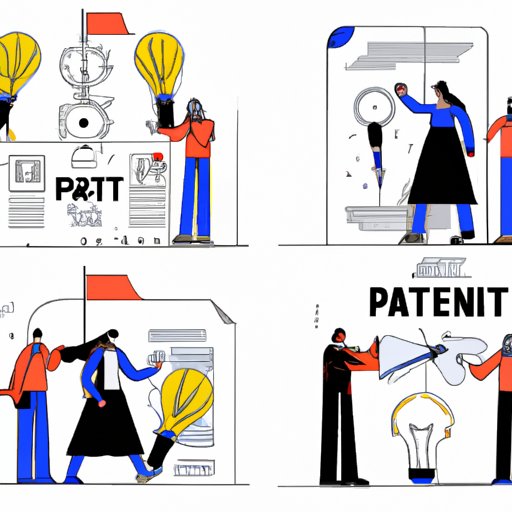Introduction
If you’re an inventor or entrepreneur, you may have an amazing idea that you believe has the potential to transform an industry. However, before you can start selling your product or solution, you need to protect your idea with a patent.
A patent gives you the right to exclude others from making, using, selling, or importing your invention for a limited period of time. This can be a powerful tool to keep competitors at bay, attract investors, and ultimately generate revenue from licensing fees or sales.
In this article, we will walk you through the step-by-step guide to obtain a patent, common mistakes to avoid, legal requirements, creative approaches, resources available, and successful case studies to inspire and inform you. By following these tips and developing your own strategies, you can increase your chances of securing a patent successfully.
Step-by-Step Guide
The first step to obtaining a patent is to file a patent application with the United States Patent and Trademark Office (USPTO) or the country where you plan to market your invention. This application must include a description, drawings, and claims of your invention. Before filing, you should conduct a preliminary search to check if someone else has already patented a similar idea.
After filing, your application will be examined by a patent examiner to determine if your invention meets specific legal criteria, such as being novel, non-obvious, and useful. This process can take several years, and you may receive rejections or requests for additional information. You can respond to these objections by amending your claims, citing references, or arguing your case. If all goes well, you will receive a Notice of Allowance and later issue a patent.
However, during this process, you may encounter potential areas of contention, such as patent infringement. This occurs when someone else uses, makes, or sells an invention that’s covered by your patent. To prevent this, you should conduct a detailed search of existing patents, perform market research, and consult with a patent attorney if necessary.
Common Mistakes
Even though obtaining a patent can be a complex process, there are some common mistakes that inventors and entrepreneurs make that can hinder their chances of success. Some of these include:
- Not conducting a thorough search of existing patents before filing.
- Not considering the commercial viability of their invention or doing market research.
- Not describing their invention with enough detail or including errors or inconsistencies in their application.
- Not responding in a timely and thorough manner to objections or questions raised by the examiner.
To avoid these mistakes, you should work with a patent attorney, conduct due diligence, create a detailed patent application, and be responsive to communication from the USPTO.
Legal Requirements
To be successful in getting a patent, you need to meet specific legal requirements. These include:
- Eligibility criteria: Your invention must fall into one of four categories: process, machine, manufacture, or composition of matter.
- Specific language requirements: Your application should use clear and concise language to describe your invention and its operation.
- Non-obviousness: Your invention must not be obvious to a person of ordinary skill in the relevant field.
- Novelty: Your invention must not be already disclosed or made available to the public.
Meeting these legal requirements can be challenging. Therefore, it’s important to work with an experienced patent attorney who can guide you through the process and help you explain your invention correctly and convincingly.
Creative Approaches
While obtaining a patent can be a demanding process, there are some creative approaches that inventive individuals and companies have used to achieve success. A few of these include:
- Finding niche areas: Rather than trying to compete in crowded fields, some inventors have focused on developing ideas in highly specialized fields where competition is minimal.
- Using open-source software: By using open-source software, inventors can avoid patent infringement issues if they release their product or solution under an open-source license.
- Using crowdfunding: By using a crowdfunding platform like Kickstarter, inventors can raise funds and validate their product before investing significant time and resources in the patent process.
By thinking outside the box and utilizing these and other approaches, inventors and entrepreneurs can increase their chances of success in getting a patent.
Resources
Fortunately, several resources are available to help inventors and entrepreneurs get the help they need to secure a patent successfully. Some of these resources include:
- Online databases and tools for searching existing patents and intellectual property.
- Organizations offering pro bono legal services for low-income inventors or startups, such as LegalZoom, Rocket Lawyer, and the Pro Bono Patent Network.
- Patent clinics at law schools, where law students can offer affordable assistance in patent application preparation and filing.
Case Studies
Many inventors, entrepreneurs, and businesses have obtained patents successfully by developing creative strategies and utilizing resources available to them. A few examples include:
- Anne Wojcicki: The founder of 23andMe, a company that provides personal DNA testing and analysis, secured several patents for their innovative genetic testing technology.
- Elon Musk: The CEO of SpaceX and Tesla has secured numerous patents for his electric vehicle and space exploration technology.
- Jerome Lemelson: The prolific inventor, entrepreneur, and philanthropist held over 600 patents for his inventions in robotics, manufacturing, and consumer products.
By studying these and other successful case studies, inventors and entrepreneurs can learn how to overcome challenges, develop winning strategies, and leverage available resources to achieve success in their patent applications.
Conclusion
Obtaining a patent can be a challenging but rewarding process for inventors and entrepreneurs. By following the step-by-step guide, avoiding common mistakes, meeting legal requirements, utilizing creative approaches, leveraging available resources, and learning from successful case studies, you can increase your chances of securing a patent successfully and ultimately transform your vision into reality.
